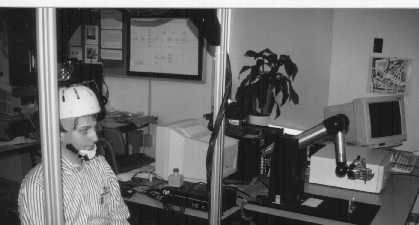


The Sensory Feedback project is investigating the effect of force feedback in helping a person better act on the environment through the aid of a robot. An important feature under study is whether proprioception can be used to improve control system performance. Another topic under study is the use of head motion as a viable input for controlling a robotic device.
Most rehabilitation robotic systems rely on visual feedback as a means of finding out what the robotic arm is doing in the workspace. Unfortunately, constant visual attention can be fatiguing and may be of limited use in tasks with tight positional constraints (e.g. a peg in hole task). Alternatively, a force reflecting telerobotic system extends a person's proprioceptive and kinesthetic sensing abilities to the slave robot by sensing the forces in the environment and feeding them back in a resolved, useful form. In a similar manner, cable-operated prostheses and even simple mouthsticks take advantage of the user's intact proprioceptive and kinesthetic sensing abilities when manipulating objects in the environment. It is observed that control of manipulation tasks is much better when these forms of feedback, coupled with visual information, are available to the user. Hence, a force-reflecting telerobotic device is expected to work like an extender.

To investigate the effects of sensory feedback on robot control, a test system has been set up which incorporates a force-reflecting head input device for individuals with high level spinal cord injuries. The head controller is electronically linked to the slave robot and contact forces sensed by the slave robot are reflected back to the user.